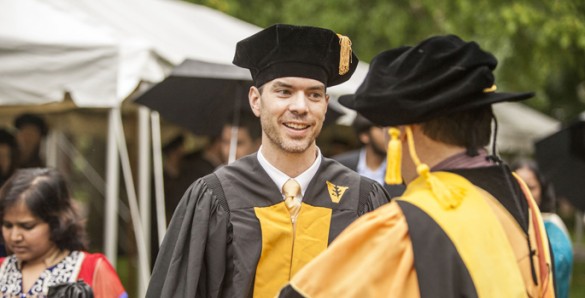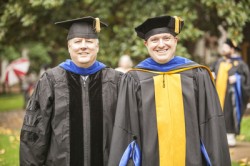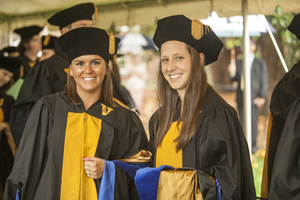
Most people probably don’t think much about the chemical compound that flavors curries and gives the Indian spice turmeric its yellow color. For Odaine Gordon, Ph.D., who celebrated his doctoral degree at last week’s Graduate School commencement, this compound — called curcumin — has special significance.
Working with Claus Schneider, Ph.D., associate professor of Pharmacology, Gordon determined the oxidative metabolites of curcumin, which could lead to new anti-cancer and anti-inflammatory therapeutics.
Gordon, who plans to do a postdoctoral fellowship in the pharmaceutical industry, expressed gratitude for his graduate school experience.

“I especially appreciate the supportive and collaborative research culture here at Vanderbilt,” Gordon said. “I have seen — and been the beneficiary of — almost daily instances of researchers going beyond their professional duties to assist and support others.”
Vanderbilt awarded 87 Ph.D. degrees to an accomplished group of students in Medical Center-related departments and programs.
Every student published at least one first-author paper, and 50 percent published two or more first-author papers. On average, graduating students published four papers as a result of their graduate work at Vanderbilt, said Abigail Brown, Ph.D., director of Outcomes Research in the Office of Biomedical Research Education and Training. Their research appeared in high-impact journals including Nature, Science, The Lancet, Molecular Psychiatry, Developmental Cell and Genes & Development, she added.
Nearly half of the students made presentations at national or international meetings, and 22 of the students had independent external fellowship funding.

Most of the newly minted Ph.D. graduates — 67 percent — are continuing their training with postdoctoral fellowships, Brown said, a proportion that is consistent with previous years. These include traditional positions in academic research laboratories as well as non-traditional industry, government and clinical fellowships.
About 28 percent of the graduates have either accepted or are in negotiations for positions that do not require a prior postdoctoral fellowship.
Teagan Walter, Ph.D., who completed her degree in December 2013, is working as a Regulatory Affairs Leader for GE Healthcare in Milwaukee, Wis. Walter was the first graduate student to complete the Vanderbilt-HHMI Certificate Program in Molecular Medicine (CPMM) and graduate with her Ph.D.

The CPMM integrates dissertation research with clinical, disease-based areas.
“CPMM was an invaluable experience,” Walter said. “Before I joined the program, I struggled a little bit feeling that my research was very isolated from the big picture of medical practice. CPMM provided exposure to new aspects of the ‘bench to bedside’ process that I hadn’t even realized existed.”
Walter credits the CPMM with introducing her to the possibility of a career in regulatory affairs. One of her current projects involves working with a group of scientists and the FDA to develop and qualify a drug development tool. The goal, she said, is to use a cell culture system to test new drugs for cardiotoxicity to avoid potentially dangerous testing in human subjects.
“The first time I heard someone (in a CPMM lecture) talk about the process of getting FDA approval to market a new drug or device, I thought to myself, ‘wow, this is incredible, and I would love to do that every day.’ And now, I couldn’t be happier with my job.”












